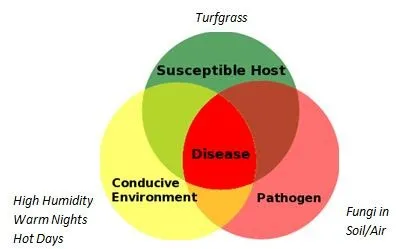There are several common Gainesville lawn diseases that can affect and cause damage to your turf throughout the year. In the industry, a grass disease is seen as a condition that interferes with the normal growth and development of the grass plant, causing the plant to look and grow abnormally.
In order for a disease in your yard to be active, 3 requirements must simultaneously be present. A susceptible host (type of grass that is susceptible to the disease), Pathogen (the actual fungi itself), and a conducive environment (favorable weather conditions for the fungi to spread). Without the presence of all 3 simultaneously, there is no disease. To visualize this lawn disease triangle, here is a diagram.

Turfgrass diseases can be difficult to identify and decipher between, as many diseases can look much alike from a distance. Noting the appearance of distinctive patterns, specific color variations, and particular grass species affected can help diagnose what disease is present or caused the damage.
Examining individual grass blades up close can reveal lesions, spots, changes in color, and stunting that can narrow the search. Mycelium, sclerotia, and masses of spores can also be present and help diagnosis the disease affecting the lawn. Some common turfgrass diseases include: Brown Patch (aka Large Patch), Pythium Root Rot, Leaf Spot, Powdery Mildew, Dollar Spot and Melting Out.
Gainesville Grass Fungus Control Tips
Curative fungicide applications are not common practice for home lawn applications, as fungicide treatments are predominantly reserved for professional Gainesville lawn applicators. Of course, the big box and garden stores do offer a few turf disease control products, but a much smaller and less-effective type than the licensed pest control applicators have access to.
Most diseases are short-lived if proper measures are taken. Depending on the type of disease and length of time it is active, varying degrees of damage and unaesthetic appearance can result. Proper measures include some steps the homeowner or property manager can take, and some should be done by a licensed professional.
- Reduce or stop watering immediately (Reduce the conducive environment of residual moisture)
- Increase sunlight on the lawn (remove any shade limbs over the affected area)
- Do not fertilize with any nitrogen products (Nitrogen causes fungi to grow just like they do turf)
- Treat with a Lawn Disease Control product (such as a fungicide)
Six Gainesville Lawn Fungus Prevention Tips
However, as the old saying goes - "An ounce of prevention is worth a pound of cure." This is true with fungus in your St. Augustine or Zoysia grass too! Here are a couple quick tips to avoid getting turf diseases in your lawn.
- Water Properly - Overwatering is the #1 cause of fungus in your Gainesville lawn. The reason? Most people set their irrigation settings up and forget about them. Regardless if it's summer, winter, spring, or fall they run the same amount of water on their lawn. (Let's be honest though, in Florida we only have 2 seasons!) If you want to "Set it and Forget it," you need to upgrade your Gainesville sprinkler system to a Smart Irrigation Controller that uses your WiFi to adjust the sprinklers to the weather stations nearest your home.
- Inspect Your Rain Sensor - (or install one if you dont have one!) This shuts off your irrigation in times of rain. It saves you money on your water bills and saves you from lawn disease, too. It's a win-win!
- Sharpen your Lawn Mower Blades - Dull blades cause the Gainesville turf to be torn instead of a clean slice. The tears leave gaping wounds for the disease to attack the lawn
- Fertilize the Lawn Properly - Nutrient deficiencies weaken the turf and make it susceptible to disease. Think of fertilizer like taking your vitamins. It keeps your immune system up and ready to fend off disease.
- Utilize Shade Landscape Beds - Instead of trying to grow turf in areas of deep shade, try a Gainesville Landscape Design with plants more suitable for the reduced sunlight and excess moisture.
- Install Proper Drainage Systems - If your lawn holds water in areas after downpours, regardless of irrigation settings and proper maintenance - you may need a french drain or downspout extension to help keep the moisture from sitting in the lawn.
Aside from environmental conditions, managing a home lawn by way of maintaining the recommended maintenance practices, improving the growing conditions, selecting resistant grass species, and by managing all turf inputs, greatly reduces disease incidence and susceptibility without the requirement of fungicides. We hope these help you reduce the need for disease control in your Gainesville Lawn.
If you have more questions about disease in your lawn, or need a licensed lawn pest professional in Gainesville, Florida, don't hesitate to call our office at (352) 378-5296 or fill out the form at the top of the page for a free proposal or to be added to our seasonal lawn tips newsletter. You can also like us on Facebook or our Gainesville Lawn Tips YouTube Channel.


